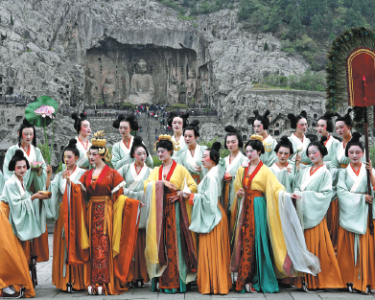Sui and Tang dynasties
Sui dynasty 581-6I8CE
Tang dynasty 618-906CE
The second Sui emperor, Yangdi, was quick to develop Luoyang. “Heaven and earth merge with each other, yin and yang work in harmony, safeguarded by four mountain passes,” he said while calling attention to its strategic tenability–it was according to Yangdi, “safeguarded by four mountain passes”. As for the economic advantages, Yangdi pointed out: “with excellent land and water transportation it provides a whole gamut of taxes and tributes.
In 605, Yangdi, whose construction spree rivaled that of Qin Shihuang, began building the new Luoyang 10km south of the Han-Wei city while digging a major canal that would link Luoyang with Yangzhou and the riches of the south. The construction of the city’s innumerable palaces would provoke the death and suffering of many laymen. It is said that around two million people were committed to the building of Luoyang and on completion it immediately became the second largest city in China, surpassed only by Chang’an. In fact Yangdi’s” decadent projects arguably led to the premature demise of the Sui dynasty. However, like Qin, the Sui had laid the foundations for another golden age, the Tang.
Tang dynasty Luoyang, a continuation of the Sui city, was known as Dongdu(the Eastern Capital), and mostly served as the secondary capital, though it was the official seat of power between 685 and 705 and again from 904 until the demise of the dynasty in 907. The Early Tang was a cosmopolitan period, open to emissaries from afar who brought their cultural trappings with them. Sports like polo from Persia became popular while instruments introduced from the Steppes and Silk Road were incorporated into the Chinese canon. The Early Tang was also expansive, its influence reaching deep into Central Asia after a serious of military victories.
Tang Luoyang’s apogee came during the reign of China’s sole empress Wu Zetian who moved her capital to Luoyang and named it Shendu(capital of the Gods).The Mingtang Hall, constructed in the palace during Wu’s reign after the model of Xia,
Shang and Zhou dynasty palace architecture became the tallest palace in Chinese history. After the reign of Empress Wu Zetian, who briefly re-instated the ancient Zhou Dynasty, the Later Tang was a period of steady decline with some exceptions.
The reign of Xuanzong for instance, was a prosperous period that oversaw a flourishing of the arts, particularly poetry, with scribes like Li Bai penning some of the finest verse in human history.
Post Tang
Though Luoyang was to serve as the capital of a few lesser dynasties, including the Later Liang and the Later Tang, its fortunes began to waver in the second millennium CE. During another golden era, the Song dynasty, established by Luoyang native Zhao Kuangyin in 960, Luoyang served as the Western capital. When Liao forces defeated the Northern Song, whose capital had been in nearby Kaifeng, the Southern Song capital was established in Hangzhou. From then on power would cease to ping pong between Xian and Luoyang, and dance between the northern frontier town of Beijing and the Yangtze River Basin instead.
In later history, Luoyang has continued to endure several cycles of destruction and rebirth, being burned down at the end of the Ming and Qing dynasties and rebuilt. Most recently, Luoyang was razed to the ground by the Japanese during the Battle for Central Henan in May 1944, which held up the occupying forces, but at a heavy cost for the city. Over more than 4.000 years of history however, Luoyang has always shown an ability to rise from the ashes. (via Luoyang Culture, Radio, Television and Tourism Bureau)





